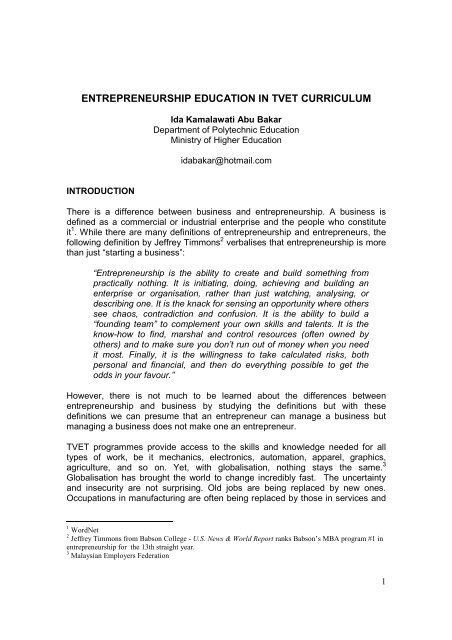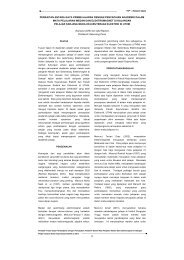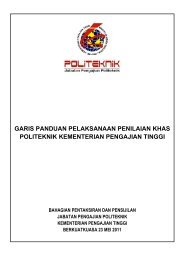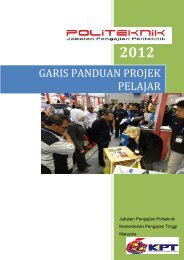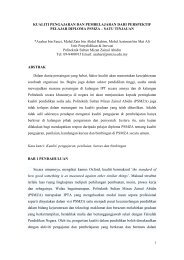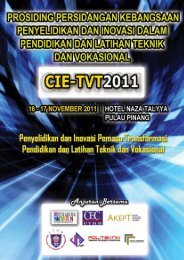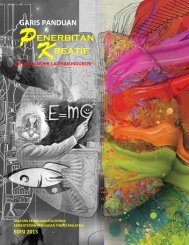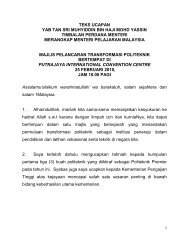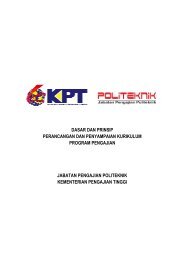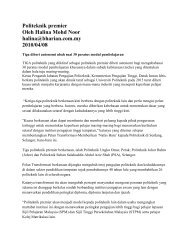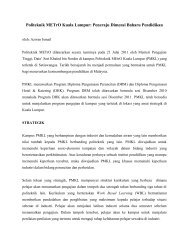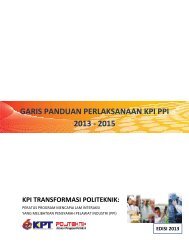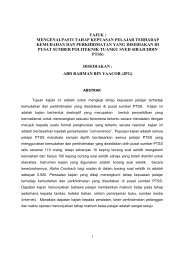Ida Kamalawati_Entrepreneurship Education in TVET Curriculum
Ida Kamalawati_Entrepreneurship Education in TVET Curriculum
Ida Kamalawati_Entrepreneurship Education in TVET Curriculum
- No tags were found...
Create successful ePaper yourself
Turn your PDF publications into a flip-book with our unique Google optimized e-Paper software.
ENTREPRENEURSHIP EDUCATION IN <strong>TVET</strong> CURRICULUM<strong>Ida</strong> <strong>Kamalawati</strong> Abu BakarDepartment of Polytechnic <strong>Education</strong>M<strong>in</strong>istry of Higher <strong>Education</strong>idabakar@hotmail.comINTRODUCTIONThere is a difference between bus<strong>in</strong>ess and entrepreneurship. A bus<strong>in</strong>ess isdef<strong>in</strong>ed as a commercial or <strong>in</strong>dustrial enterprise and the people who constituteit 1 . While there are many def<strong>in</strong>itions of entrepreneurship and entrepreneurs, thefollow<strong>in</strong>g def<strong>in</strong>ition by Jeffrey Timmons 2 verbalises that entrepreneurship is morethan just “start<strong>in</strong>g a bus<strong>in</strong>ess”:“<strong>Entrepreneurship</strong> is the ability to create and build someth<strong>in</strong>g frompractically noth<strong>in</strong>g. It is <strong>in</strong>itiat<strong>in</strong>g, do<strong>in</strong>g, achiev<strong>in</strong>g and build<strong>in</strong>g anenterprise or organisation, rather than just watch<strong>in</strong>g, analys<strong>in</strong>g, ordescrib<strong>in</strong>g one. It is the knack for sens<strong>in</strong>g an opportunity where otherssee chaos, contradiction and confusion. It is the ability to build a“found<strong>in</strong>g team” to complement your own skills and talents. It is theknow-how to f<strong>in</strong>d, marshal and control resources (often owned byothers) and to make sure you don’t run out of money when you needit most. F<strong>in</strong>ally, it is the will<strong>in</strong>gness to take calculated risks, bothpersonal and f<strong>in</strong>ancial, and then do everyth<strong>in</strong>g possible to get theodds <strong>in</strong> your favour.”However, there is not much to be learned about the differences betweenentrepreneurship and bus<strong>in</strong>ess by study<strong>in</strong>g the def<strong>in</strong>itions but with thesedef<strong>in</strong>itions we can presume that an entrepreneur can manage a bus<strong>in</strong>ess butmanag<strong>in</strong>g a bus<strong>in</strong>ess does not make one an entrepreneur.<strong>TVET</strong> programmes provide access to the skills and knowledge needed for alltypes of work, be it mechanics, electronics, automation, apparel, graphics,agriculture, and so on. Yet, with globalisation, noth<strong>in</strong>g stays the same. 3Globalisation has brought the world to change <strong>in</strong>credibly fast. The uncerta<strong>in</strong>tyand <strong>in</strong>security are not surpris<strong>in</strong>g. Old jobs are be<strong>in</strong>g replaced by new ones.Occupations <strong>in</strong> manufactur<strong>in</strong>g are often be<strong>in</strong>g replaced by those <strong>in</strong> services and1 WordNet2 Jeffrey Timmons from Babson College - U.S. News & World Report ranks Babson’s MBA program #1 <strong>in</strong>entrepreneurship for the 13th straight year.3 Malaysian Employers Federation1
the knowledge <strong>in</strong>dustries. Someth<strong>in</strong>g must be done for Malaysians to survive asthey could no longer get employment easily.<strong>Entrepreneurship</strong> is a creative action and an entrepreneur is therefore an<strong>in</strong>novator. This means to say that entrepreneurship is a creative and <strong>in</strong>novativeresponse to the environment. 4 These k<strong>in</strong>ds of responses will result <strong>in</strong> the<strong>in</strong>troduction of new products or services <strong>in</strong>to the economy or <strong>in</strong> the enhancementof exist<strong>in</strong>g approaches <strong>in</strong> provid<strong>in</strong>g products or services. Research studies showthat countries that have gone through rapid economic growth have always had alarge number of adventurous and enterpris<strong>in</strong>g people.ENTREPRENEURSHIPThe law of supply and demand should be understood as noth<strong>in</strong>g more than aformula that directs to the opportunity for changes <strong>in</strong> bus<strong>in</strong>ess. When employeesare no longer needed by a bus<strong>in</strong>ess, it may mean that:a. the bus<strong>in</strong>ess has a larger supply of the product than customerdemands,b. the product costs have risen to the state that the price they charge thecustomer is very high,c. there is less demand <strong>in</strong> the market for the product,d. a new competition has entered the market and their offer<strong>in</strong>g is moreattractive to customers.There has been a global realisation that entrepreneurial capabilities are a criticalvehicle for economic development. For an economy to develop, there is the needto supply more entrepreneurs. Entrepreneurs <strong>in</strong>troduce new methods ofproduction and new products <strong>in</strong>to an economy.Accord<strong>in</strong>g to Doriat (1999), perhaps the biggest misconception about an idea fora bus<strong>in</strong>ess is that it must be unique, obsessed with the thought that the ideamight be stolen. 5 Raymond Kroc, the founder of McDonalds did not <strong>in</strong>vent thefast-food bus<strong>in</strong>ess, but he def<strong>in</strong>itely revolutionised it. In a short period of time,McDonalds grew <strong>in</strong>to what is known now, an <strong>in</strong>stitution. He did not <strong>in</strong>vent thefast-food hamburger restaurant but he did improved upon it, and set a newstandard <strong>in</strong> the <strong>in</strong>dustry. Conrad Hilton, the founder of Hilton Hotel empire wasnot the first man to create a cha<strong>in</strong> of hotels <strong>in</strong> various locations. However, hismethodology made him a great fortune and piloted a revolution <strong>in</strong> the hotel<strong>in</strong>dustry. These are examples of entrepreneurs, not just bus<strong>in</strong>essmen. There is aneed to supply more entrepreneurs for an economy to expand becauseentrepreneurs are agents of change.4 Cathleen M. Sekwao, Dar es Salaam Technical College.5 Miroslaw Malek & Peter K. Ibach, Technische Universität Berl<strong>in</strong>.2
ENTREPRENEURSHIP EDUCATIONEntrepreneurs are the eng<strong>in</strong>es of Malaysia’s economy. They create new jobs anddevelop new <strong>in</strong>novations. Entrepreneurs can progress and prosper just aboutanywhere. <strong>Entrepreneurship</strong> education as part of <strong>TVET</strong> curriculum is a brilliantvehicle for teach<strong>in</strong>g students about change. <strong>Entrepreneurship</strong> education is anapproach <strong>in</strong> teach<strong>in</strong>g students to embrace change rather than to fear it. Thosewho fear change will not set a goal because sett<strong>in</strong>g progressively higher goalsdrags people out of the comfort zone. Successful people constantly challengethemselves and stimulate their m<strong>in</strong>ds by ventur<strong>in</strong>g out of their comfort zone. As aresult, each time they take on a new challenge, their comfort zone expands toencompass it. 6<strong>Entrepreneurship</strong> education is about survival, not just about teach<strong>in</strong>g students tooperate a bus<strong>in</strong>ess. Through entrepreneurship education, students do not justlearn to start a bus<strong>in</strong>ess, but they also learn to take risks, manage results, andlearn from the outcomes. 7 Entrepreneurs love what they do. It is that love thatsusta<strong>in</strong>s them when the bus<strong>in</strong>ess gets challeng<strong>in</strong>g. And it is the love for theirproduct or service that makes them so efficient at do<strong>in</strong>g bus<strong>in</strong>ess.RATIONALE FOR ENTREPRENEURSHIP EDUCATIONThe current design of <strong>TVET</strong> <strong>in</strong> Malaysia typically leans on the follow<strong>in</strong>gassumptions:a. <strong>TVET</strong> prepare students to become employable <strong>in</strong> exist<strong>in</strong>gorganisations,b. Students who aspire to operate a bus<strong>in</strong>ess will follow different careerpaths and require different skills than future employees of companiesand, therefore, should be enrolled <strong>in</strong> special entrepreneurshipprogrammes, orc. Entrepreneurial skills are supplementary, not essential to formaleducation, so the exceptional student who chooses self-employmentcan acquire them as electives or <strong>in</strong> cont<strong>in</strong>u<strong>in</strong>g education programmes.The general th<strong>in</strong>k<strong>in</strong>g is that entrepreneurs are born and/or ga<strong>in</strong> experience andadditional technical knowledge by work<strong>in</strong>g for someone else before becom<strong>in</strong>g anentrepreneur. It is undeniable that some people just “have it” but for the rest ofthe <strong>in</strong>dividuals education, tra<strong>in</strong><strong>in</strong>g, and guidance can help. Individuals whoreceive tra<strong>in</strong><strong>in</strong>g <strong>in</strong> entrepreneurship are more likely to start a bus<strong>in</strong>ess, and mostimportantly to susta<strong>in</strong> and grow a bus<strong>in</strong>ess.6 Robert M. Unger & John Kuppilas, Jr, Success is a Choice.7 Cathy Ashmore, The Consortium for <strong>Entrepreneurship</strong> <strong>Education</strong>.3
If one understands the technical work of a bus<strong>in</strong>ess, one understands a bus<strong>in</strong>essthat does the technical work. The technical work of a bus<strong>in</strong>ess and a bus<strong>in</strong>essthat does technical work are two totally different th<strong>in</strong>gs. 8 For a technician, thebus<strong>in</strong>ess is not a bus<strong>in</strong>ess but a place to go to work. How talented one is as atechnician will not determ<strong>in</strong>e how successful one will be <strong>in</strong> build<strong>in</strong>g a bus<strong>in</strong>essthat grows to substantial value. A foreman stays a foreman. A chef stays a chef.Also a common misconception <strong>in</strong> <strong>TVET</strong> is that by <strong>in</strong>still<strong>in</strong>g a subject or a course<strong>in</strong> bus<strong>in</strong>ess, students can manage to become entrepreneurs. These bus<strong>in</strong>esssubjects or courses often consist of topics on account<strong>in</strong>g, licens<strong>in</strong>g, fund<strong>in</strong>g andgrants, taxation, tenders and contracts, and other basic bus<strong>in</strong>ess start-ups. Manyof these courses generally only address the competencies of a worker <strong>in</strong> abus<strong>in</strong>ess sett<strong>in</strong>g. Often the courses are built as such that assumes studentsshould develop skills to be some k<strong>in</strong>d of manager or advance up the careerladder <strong>in</strong> a large bus<strong>in</strong>ess. Rarely do bus<strong>in</strong>ess courses assume that students willbe a bus<strong>in</strong>ess creator and owner, and to be <strong>in</strong> control of their own <strong>in</strong>come.The 2006 Polytechnic Tracer Study <strong>in</strong>volv<strong>in</strong>g graduates of June 2005 andDecember 2005 from 18 polytechnics <strong>in</strong>dicates only 1.7% of graduates are selfemployed(see Table 1):Table 1: Job Status, Polytechnic Tracer Study 2006Job Status Level of Study TotalDiploma CertificatePermanent 63.2% 41.3% 54.5%Temporary 15.9% 32.1% 22.3%Contract 18.1% 21.7% 19.5%Work with Family 1.1% 3.1% 1.9%Self-employed 1.6% 1.8% 1.7%It could imply that graduates simply lack the confidence needed to start up theirown enterprises when there are competitors <strong>in</strong> the market, and the lack ofcourage to take on the entrepreneurial role us<strong>in</strong>g only the technical skills andsome basic bus<strong>in</strong>ess knowledge they have. It is learned that these graduateshad the <strong>in</strong>terest but lack the capacity to do so. Under item <strong>Entrepreneurship</strong>Tra<strong>in</strong><strong>in</strong>g <strong>in</strong> the report 9 (see Table 2) 71.5% respondent say they are <strong>in</strong>terested tobecome entrepreneurs as compared to 28.5% who are not. However, only31.95% claim to have gone through some form of entrepreneurship tra<strong>in</strong><strong>in</strong>g at<strong>in</strong>stitution level (see Table 3)8 Michael E. Gerber, The E-Myth Contractor.9 Polytechnic Tracer Study 2006.4
Table 2:Aspire to Become Entrepreneur, Polytechnic Tracer Study 2006Do you aspire to Level of StudyTotalbecome anDiploma Certificateentrepreneur?Yes 73.2% 69.8% 71.5%No 26.8% 30.2% 28.5%Table 3:<strong>Entrepreneurship</strong> Tra<strong>in</strong><strong>in</strong>g, Polytechnic Tracer Study 2006Did you undertake Level of StudyTotalanyDiploma Certificateentrepreneurshiptra<strong>in</strong><strong>in</strong>g at the<strong>in</strong>stitution?Yes 35.8% 28.1% 31.95%No 64.2% 71.9% 68.5%REQUIREMENTS BY THE MQFThe Malaysian Qualifications Framework also outl<strong>in</strong>es the Managerial and<strong>Entrepreneurship</strong> Skills as one of the eight learn<strong>in</strong>g outcome doma<strong>in</strong>s that mustbe <strong>in</strong> every programme accreditation (see Table 4).Table 4: MQF Eight Doma<strong>in</strong>s of Programme Learn<strong>in</strong>g OutcomesPracticalSkillsSocial Skills &ResponsibilitiesInformationManagement &Lifelong Learn<strong>in</strong>gSkillsProblem Solv<strong>in</strong>g& Scientific SkillsCommunication,Leadership &Team SkillsManagerial &EntrepreneurialSkillsKnowledgeofDiscipl<strong>in</strong>eAreasValues, Attitude &ProfessionalismAs student achievements are measured by learn<strong>in</strong>g outcomes, students shouldbe able to demonstrate entrepreneurial as well as managerial skills.Entrepreneurial m<strong>in</strong>dsets and skills can best be promoted through learn<strong>in</strong>g by5
do<strong>in</strong>g and experienc<strong>in</strong>g entrepreneurship <strong>in</strong> practice, <strong>in</strong> the forms of practicalprojects and activities. 10 In fact, all types of educational programmes cancontribute to the experience of becom<strong>in</strong>g an entrepreneur. <strong>Education</strong> at all levelscan <strong>in</strong>clude experiences that help students see opportunities and possibilities. Itcan be a part of any topic, module or course.THE DIFFERENCES<strong>TVET</strong> produces technically qualified graduates for wage employment. Withadded courses <strong>in</strong> bus<strong>in</strong>ess studies, <strong>TVET</strong> graduates could become managers.However, when entrepreneurial elements like creativity, <strong>in</strong>novations, risk-tak<strong>in</strong>g,and persistence is <strong>in</strong>fused <strong>in</strong> the curricula, it will enable <strong>TVET</strong> graduates to alsobecome entrepreneurs and job creators <strong>in</strong>stead of be<strong>in</strong>g sorely job seekers. Thecharacteristics of an entrepreneur, a manager and a technician are different, theyalmost look conflict<strong>in</strong>g. Table 5 shows the straightforward differences asdescribed by Gerber (2007).Table 5:The Differences between the Entrepreneur, the Manager, the TechnicianEntrepreneur Manager TechnicianVisionary Planner DoerF<strong>in</strong>der M<strong>in</strong>der Gr<strong>in</strong>derThus, what we aspire to produce by the end of the day should shape the way thecurriculum is designed. For this reason, balance needs to be created with<strong>in</strong>these three to create a successful outcome.HOW TO INCORPORATE ENTREPRENEURSHIP IN CURRICULUM?I would like to suggest two types of approaches to <strong>in</strong>tegrat<strong>in</strong>g entrepreneurialskills and behaviours <strong>in</strong>to an educational programme:a. Merged - Integrate entrepreneurial content <strong>in</strong>to exist<strong>in</strong>g courses, orb. Simulated - Students take on roles and make decisions related to a realor simulated enterprise.The Merged ApproachThis approach comb<strong>in</strong>es entrepreneurship education throughout the programmeof study with<strong>in</strong> the scope of regular courses. Students are <strong>in</strong>troduced gradually to10 Commission of the European Communities.6
us<strong>in</strong>ess concepts and are encouraged to comprehend and develop theirbus<strong>in</strong>ess plans as they go along. It also allows teachers to apply pedagogicaltechniques that will <strong>in</strong>spire creativity, flexibility, risk tak<strong>in</strong>g, <strong>in</strong>dependence, andother entrepreneur traits throughout the entire educational programme.Content and pedagogy <strong>in</strong> exist<strong>in</strong>g courses should be altered to <strong>in</strong>corporatemanagement and bus<strong>in</strong>ess issues. For example <strong>in</strong> CNC Mach<strong>in</strong><strong>in</strong>g, <strong>in</strong>cludeissues that stipulate knowledge of customer’s requirements, matters on cost<strong>in</strong>gand budget<strong>in</strong>g, schedul<strong>in</strong>g, and decisions about up-grad<strong>in</strong>g or replacement ofequipment. Technical skills is believed to be more easily and effectively learned<strong>in</strong> a problem-oriented bus<strong>in</strong>ess context. 11 Entrepreneurial concepts are<strong>in</strong>troduced by structur<strong>in</strong>g projects <strong>in</strong> a team-oriented approach with projectmanagement, problem-solv<strong>in</strong>g, while document<strong>in</strong>g and communicat<strong>in</strong>g technical<strong>in</strong>formation effectively.The Simulated ApproachThis approach meanwhile is placed somewhere <strong>in</strong> the middle or near the end ofa programme of study so students already have built their foundation skills andsubsequently learn to solve complex problems associated with creat<strong>in</strong>g andrunn<strong>in</strong>g a company. The entrepreneurial experience becomes not only anexperience to learn entrepreneurial skills but also to apply technical knowledgethroughout the experience.The activities take place outside the scope of traditional courses and look like a“laboratory practice” where students come together for several hours weekly torun a fictitious bus<strong>in</strong>ess. It is based on the idea of creat<strong>in</strong>g and runn<strong>in</strong>g m<strong>in</strong>icompaniesto simulate the operations of real companies and real economicactivities. However, <strong>in</strong>stead of us<strong>in</strong>g techniques like case studies and roleplay<strong>in</strong>g,these m<strong>in</strong>i-companies trade with each other.Table 6 demonstrates the comparisons of approaches and traits of these two.Table 6: Comparisons of ApproachesCharacteristicApproachMergedSimulated<strong>Curriculum</strong> Revised curriculum Limited curriculum<strong>Curriculum</strong> Content Competency driven Situation drivenPedagogy Competency based Situation orientedTeach<strong>in</strong>g & Learn<strong>in</strong>g Individuals Cross-discipl<strong>in</strong>aryStudentsAll <strong>in</strong> same programme Multidiscipl<strong>in</strong>aryPlann<strong>in</strong>g Entire reform Cont<strong>in</strong>uousImplementation Comprehensive ElectivePrivate sector Involvement Advisor Partner11 Politeknik Manufaktur Bandung7
Academic relationship Instructors Peer likeRepresentation of real world Case studies Realistic or simulatedTHE CHALLENGES<strong>Entrepreneurship</strong> grows <strong>in</strong> an environment that encourages dynamic ways oflearn<strong>in</strong>g. To facilitate this, assistance is needed and should be comprehensive.For example:• Include provid<strong>in</strong>g <strong>in</strong>itial and <strong>in</strong>-service tra<strong>in</strong><strong>in</strong>g for teachers. Teachersshould be given the time and resources to design, manage, and evaluateactivities, mak<strong>in</strong>g teach<strong>in</strong>g material available and grasp<strong>in</strong>g their duties.• Equity and ethics must be emphasised.• Best practices should be benchmarked and dissem<strong>in</strong>ated.• The commitment of academic leaders and governance is crucial, as wellas parental <strong>in</strong>volvement.• The private sector should become more <strong>in</strong>volved by sponsor<strong>in</strong>g certa<strong>in</strong>projects and by <strong>in</strong>volv<strong>in</strong>g directly as mentors. The private sector shouldsee this <strong>in</strong>volvement as a long-term <strong>in</strong>vestment, and as an essentialaspect of their corporate social responsibility.CONCLUSIONMak<strong>in</strong>g entrepreneurship culture acceptable and appreciated is a challenge andmay require a cultural change <strong>in</strong> attitude to self-employment. However, it isnecessary to <strong>in</strong>corporate <strong>Entrepreneurship</strong> <strong>Education</strong> <strong>in</strong> the curriculum toprepare students for survival. It is a channel for <strong>TVET</strong> students to confront aproblem and f<strong>in</strong>d a solution. We should help students understand their choices <strong>in</strong>a free market economy, and support them to seek entrepreneurial opportunitiesfor themselves. It may be the only way to ensure that Malaysians are ready toface the harsh economic conditions <strong>in</strong> the future while contribut<strong>in</strong>g positively tothe development of our nation. Even if self-employment is not a choice, agraduate with entrepreneurial qualities will be an asset to any company. This isthe mission of entrepreneurship education <strong>in</strong> <strong>TVET</strong> curriculum.8
REFERENCESAshmore, C. Consortium for <strong>Entrepreneurship</strong> <strong>Education</strong>, http://www.entreed.org/_entre/criteria.htm.Retrieved August 2007.Gerber, M.E. The The E-Myth Revisited: Why Most Small Bus<strong>in</strong>esses Don't Workand What to Do About It, http://www.bizsum.com/articles/art_the-e-myth.php.Retrieved October 2007.Haddawy, P. Innovativeness as a Criterion for Accreditation. Paper presented toAPQN Conference & AGM 2007.06/02/2007Hupalo,P.I. Articles about <strong>Entrepreneurship</strong> And Small Bus<strong>in</strong>ess,http://www.th<strong>in</strong>k<strong>in</strong>glike.com. Retrieved August 2007.Kayne, J.A. & Altman, J.W. (2005) Creat<strong>in</strong>g Entrepreneurial Societies: The Roleand Challenge for <strong>Entrepreneurship</strong> <strong>Education</strong>. Journal of Asia <strong>Entrepreneurship</strong>and Susta<strong>in</strong>ability.Malek M. & Ibach, P.K. (1999) Technical <strong>Entrepreneurship</strong>, Berl<strong>in</strong>. http://www.<strong>in</strong>formatik.hu-berl<strong>in</strong>.de/~rok/entrepreneurship. Retrieved September 2007.Sekwao C.M. Institutionalization of <strong>Entrepreneurship</strong> <strong>Education</strong> DevelopmentWith A Focus On Women In Technical <strong>Education</strong> In Tanzania,http://www.wigsat.org. Retrieved August 2007.Syed Husman, S.H. (2005) Meet<strong>in</strong>g The Needs of Employers. Paper presentedto National Sem<strong>in</strong>ar on the Development of Technology and <strong>TVET</strong>-In Era ofGlobalisation. Kuala Lumpur, 24/08/ 2005.Timmons, J.A. Babson College, http://www3.babson.edu/eship/. RetrievedAugust 2007.Unger, R.M. & Kuppillas, J.J. (1995) Success Is A Choice, New York: AQ.Implement<strong>in</strong>g the Community Lisbon Programme: Foster<strong>in</strong>g EntrepreneurialM<strong>in</strong>dsets Through <strong>Education</strong> And Learn<strong>in</strong>g, Commission of The EuropeanCommunities, Brussels. 13/02/2006Polytechnic Tracer Study 2006, Department of Polytechnic and CommunityCollege <strong>Education</strong>, M<strong>in</strong>istry of Higher <strong>Education</strong>.Politeknik Manufaktur Negeri Bandung- “Precision and Speed, VocationalOriented Higher <strong>Education</strong> and Entrepreneurial Polytechnic”, http://www.polmanbandung.ac.id/. Retrieved October 2007.9
Tra<strong>in</strong><strong>in</strong>g Tomorrow's Entrepreneurs,http://ec.europa.eu/enterprise/entrepreneurship/tra<strong>in</strong><strong>in</strong>g_en.htm. RetrievedSeptember 2007.10


